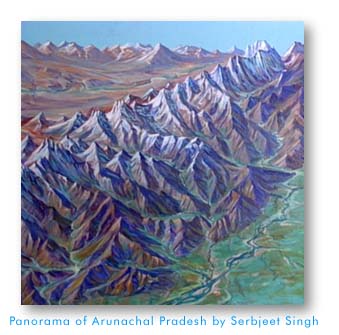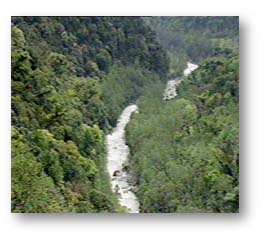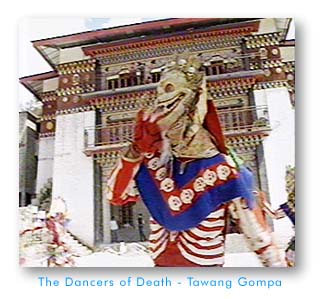Karamjeet Singh's Himalayan Home



Imagine yourself flying high, at an altitude of almost fifty thousand meters, five times the
height of Mt. Everest, above Lakhimpur in The Brahmaputra valley and looking north..... this
is what you will see...
On the far right, almost touching the horizon, is the immense, solitary mountain,
Namche Barwa, 7756 meters high. Geographically speaking, Namche Barwa is the starting
point of the 2500 km Great Himalaya Range. Here, at one of the range's highest points, the
Brahmaputra has chosen to enter India. The Gorge of the Yarlung Tsangpo, as the
Brahmaputra is known in Tibet, is one of the wildest and least explored spots on Earth. Here the river
has cut across the range in a gorge that's three times as deep as the Grand Canyon.
The main chain, meanwhile, sweeps off to the southwest in a splendor of dazzling peaks.... Tsa Ri,
Gorichen, Kangto and onto the easternmost peaks of the Bhutan Himalaya.
It is in West Kameng district that the Great Himalaya enters Arunachal from Bhutan, in a
maze of valleys and ridges varying in altitude from a mere 800 meters to 7000 meters.
The first great mountain on the range, in Arunachal, is the Kangto Massif. In it's
snowfields and glaciers, it's knife edged ridges that trap the monsoon clouds, gather the
waters which combine to form the Kameng.

The Kameng along with it's tributaries is the principal architect of the landscape of Western
Arunachal and one of the major tributaries of the Brahmaputra.
Further to the East, the Subansiri and the Dihang, as the Brahmaputra is known here,
gouge their way down the Great Himalayan watershed.
The catchement of these rivers are clothed with extremely dense rainforests, for the large
part unexplored. These forests are the reason for Arunachals incredible biodiversity, home
as they are to countless species of flora and fauna. Like the South American rainforests, the
permanent gloom of these huge forests is a potential unrivalled source of hitherto  undiscovered alkaloids and drugs, cures for diseases yet to hit humanity as well as the
plethora we already have around.
undiscovered alkaloids and drugs, cures for diseases yet to hit humanity as well as the
plethora we already have around.
Today, these great forests are under increasing threat from rapacious timber interests.
A large number of wood based industries like plywood and veneer mills have
mushroomed in the state in the last four years or so. Probably the maximum number yet
came up in the last two years. A large number of these are located in remote areas, rendering
monitoring and control by the forest department, very difficult. Also the total capacity of
these industries appears to be much in exess of the projected turn-over, leaving room for
suspicions that all may not be above board. How much excess can be gauged from the
fact that the State govt issues annual licences for 9,000 cubic feet of timber - enough to
keep one decent sized saw mill busy. The state has nearly 300 saw mills and veneer
factories of all sizes !!
Increasing local populations, migration from the plains, roadside labour etc are all doing
their mite to contribute to defforestation.
Traditionally tribal populations in these areas have farmed using the technique known as
slash and burn cultivation. This involves firing a stretch of forest and clearing it for
farming operations. The strip is then intensely cultivated till returns become marginal and
then another strip is cleared. Forest cover used to regenerate fairly fast but nowadays
with increasing population pressures the forests don't seem to stand much of a chance.
Like the enchanted forest of the fairy tales, Arunachal forests are full of medicinal herbs
with magical properties, many as yet not fully explored. For others such as Texas Bacata,
the yew tree, the story is different. The bark of the tree is processed for Taxol - a drug used
in the treatment of ovarian cancer. The exploitation of the tree has taken place so ruthlessly
that it has virtually vanished from the state.

The disappearance of the forests involves the extinction of many plant and animal species
including the tree clinging orchids.At the Orchid Research Center at Tipi, the world
renowned Dr. Rao and his colleagues have done pioneering work towards preserving the
state's gene pool wealth as actualised in it's nearly 500 orchid species. Dr Rao has now
some partners in his work in the form of the W.W.F and the Indian Army. Extremely endangered species
are now being replanted in Army cantonments, the theory being that these offer actually protected
areas as opposed to reserves and protected areas which exist only on paper
Contributing a lot to the unexplored state of Arunachal's forests are it's leeches which
besides being longer, averaging 4 - 5 inches, than those found anywhere in the Himalayas, range upto an incredible
12,000 feet above sea level. Most ubiquitous is the famous Tiger leech of Tawang, so called because
of it's colouration. Armed with extremely perceptive receptors the leech is alive to the
slightest vibration towards which it homes in. These tropical leeches belonging to the order
Haemadipsa, drop onto travellers from trees or bushes or climb their legs find a pulsating
vein close to the surface and fasten on. Their saliva contains hirudin, an important
anticoagulant widely used in medicine. Capable of ingesting three times their own body
weight in blood the leech then drops off and seeks cover, for it takes it a couple of
months to digest it's feast.
Leeches were used in traditional medicine for bloodletting and have been recently used in
very delicate brain surgery in the west, in order to relieve congestion from a particular area
without side-effects.
Arunachal is the land of the dawn in more ways than one. Mankind has apparently
prospered here since about 2,000 BC, going by the number of tribes that reside within it's
borders. For the high Himalayan areas, access from the north, the Tibetan or Bhutanese
side, has always been easier wheras the dense rainforests served as an effective barrier to
further southward movement. Thus in Arunachal, as all over the Himalayas, the Upper hills
are primarily Buddhist, though the people retain many influences of their original animist
faiths.
Arunachal is also the home of twenty two major tribes, who even today, mainly due to
Arunachal's restricted status, fiercly stick to their traditional lifestyles. In fact most of these
tribes gave the British a hard time when the northeast frontier was being amalgamated with
the rest of British India. Because they stuck so zealously to their independence, they, with
highly developed cultures, were dubbed Daflas or wild-men. Their extremely effective  jungle warfare tactics, and the Amazonian rain forests, made this place the frontier of
exploration throughout the last century.
jungle warfare tactics, and the Amazonian rain forests, made this place the frontier of
exploration throughout the last century.
The major tribe of interest to us, as a mountain tribe, are the Monpas. Tribes of Indian-Tibetan- Burmese origin
their beliefs still retain elements of animism and shamanism though the influence of
Buddhism is particularly marked. With 40,000 members spread over Arunachal, Bhutan and
Southern Tibet, the Monpas are one of the largest ethnic minorities in the Eastern Himalaya.
The spiritual center of the universe for the Monpas is the Tawang Galden Namgyal Lhatse - the divine site chosen
by the celestial white horse. Legend has it that the site for the building of Tawang monastery was shown to
the Mira lama in a dream. A white horse pawed the ground where construction of the monastery was started.
Construction began in the 1640's and was completed some forty odd years later. Centuries of peace and prayer
were shattered by the Chinese invasion in 1962. The monastery was badly damaged during this period with the
red gaurds destroying priceless murals and tankhas. Reconstruction work is still on in various parts of the monastery.
Unlike many monastaries in Ladakh and Zanskar, Tawang is vibrantly alive in this modern
age. In Tawang's renowned library, Buddhist scholars have access to thousands of
block printed commentaries and treatises on Mahayana Buddhism as well as original
manuscripts. Interestingly, the paper used is also produced by the Monpas locally, from the
bark of the Hong Seng tree.
In the monastery courtyard, the Dancers of Death are going through their steps. Their leaping  criss-crossing advance symbolizes Dorje or Thunderbolt, cleansing evil from their path.
criss-crossing advance symbolizes Dorje or Thunderbolt, cleansing evil from their path.
The masks with five skulls arrayed on the crown remind the pious observer of the
transcience of all life and exhort him to perform good deeds in this lifetime. Likewise the
red and blue colours serve the same admonishing function in the dances. Eerie
sounding whistles are built into the masks, providing a spine chilling counterpoint.
The dancers follow the strict code given in the books written upon hand made paper
produced in the Gompa itself. Before the dance the rules are read out. These rules indicate
the movements, gestures, tempo as well as usage of costumes and props.
The most striking feature of the Arunachal Eco-sysytem is that at altitudes varying from
500 meters to 7000 meters, from the floor of the Brahmaputra valley to the crest of the
Great Eastern Himalaya, fauna and flora ranging from the tropical to the alpine is found
within a distance of 200 kilometers as the crow flies.

As in other parts of the Eastern Himalayas, the tropics meet up with the Himalayan
temperate zone with surprising suddenness. The tree line gives way to the shimmering
Himalayan glaciers which form a dramatic climatic border separating the dry regions of
the north from areas where dense evergreen forests flourish at 3,000 meters.
All the upper limits of vegetation applicable in the Western Himalayas have to be
appreciably scaled up here These can be termed upper mixed forests with Ban oak,
rhododendron and higher up, Silver fir, the dominant species.
Arunachal is virgin territory. Geo-political circumstances have contributed to it's isolation
- the entire state is an inner-line area reequiring special permits to enter, with the result that
it is a model ecosystem with some of India's most vibrant and undiluted tribal cultures,
and we can but hope that as the modern world encroaches, it treads lightly.


This page hosted by
 Get your own Free Home Page
Get your own Free Home Page
Web Page Design and Images Copyrightę: Karamjeet Singh





 undiscovered alkaloids and drugs, cures for diseases yet to hit humanity as well as the
plethora we already have around.
undiscovered alkaloids and drugs, cures for diseases yet to hit humanity as well as the
plethora we already have around.
 jungle warfare tactics, and the Amazonian rain forests, made this place the frontier of
exploration throughout the last century.
jungle warfare tactics, and the Amazonian rain forests, made this place the frontier of
exploration throughout the last century. criss-crossing advance symbolizes Dorje or Thunderbolt, cleansing evil from their path.
criss-crossing advance symbolizes Dorje or Thunderbolt, cleansing evil from their path.

